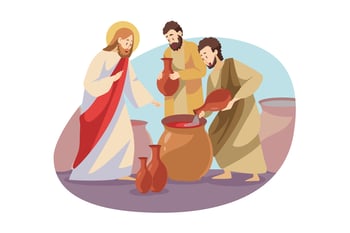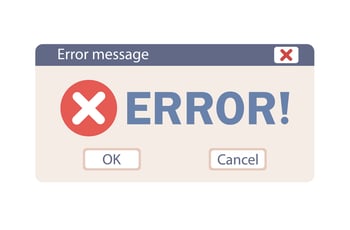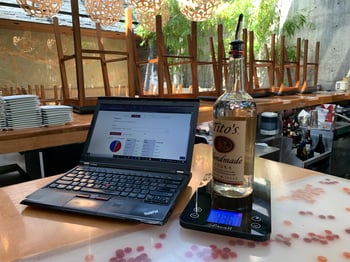 At Bar-i, we often see a phenomenon we call the “Jesus pour” when we first start working with new clients. To be clear, the “Jesus pour” is a term unique to our internal Bar-i vocabulary. You won’t hear it when you work with other bar inventory providers. To address the elephant in the room, we’re not religious – we just think the name has a ring to it and is a bit funny. And we like things that are funny. So, the name stuck.
At Bar-i, we often see a phenomenon we call the “Jesus pour” when we first start working with new clients. To be clear, the “Jesus pour” is a term unique to our internal Bar-i vocabulary. You won’t hear it when you work with other bar inventory providers. To address the elephant in the room, we’re not religious – we just think the name has a ring to it and is a bit funny. And we like things that are funny. So, the name stuck.
You may be wondering, what does the “Jesus pour” refer to and why are we getting biblical with our bar inventory audits? The reference comes from a well-known bible passage where Jesus was at a wedding and the wine ran out. He was able to save the day by turning water into wine, providing the guests with plenty to drink for the rest of the wedding. When we refer to a “Jesus pour,” we’re essentially saying that extra quantity of a particular product appeared out of nowhere, as if water was being turned into wine.
Unlike the famous bible passage we’re referencing, we fully realize that performing miracles isn’t in the realm of a bar manager’s powers. For us mere mortals, the only way you can get more of a specific product is to buy more – it doesn’t just appear out of thin air. The reality is, if we encounter a “Jesus pour,” it’s not indicative of some miracle. Rather, it’s a sign that a mistake has been made in the inventory process.
The mistake we’re referring to is negative usage. But if you know what you’re doing, you can actually use this evidence of negative usage to your advantage and leverage it to improve your bar inventory process. In that regard, our team is able to turn a “Jesus pour” into a “mini-miracle” that helps enhance the accuracy of your inventory results over time.
What Is Negative Usage in Bar Inventory?
Negative usage refers to a situation where you have more of a product on-hand one week than you had the previous week. If a product “grows” in this manner, then you can be fairly certain that an error occurred.
Let’s examine how negative usage would look in real life at your bar. If you have 1 bottle of Jack Daniels when you did your inventory count last week, you purchased 3 more bottles this week, and your sales report shows that you poured 3.5 bottles this week, then you should have 0.5 bottles of Jack Daniels remaining. If your inventory count shows that you have 1.5 bottles of Jack Daniels on-hand, then it indicates negative usage. In almost every situation, this should alert you to the fact that an error was made during your inventory process.

What Are the Causes of a Negative Usage Error?
There are three common causes of a negative usage error:
- Inaccurate measurement of a low volume or hard to measure bottle
- Missing invoice
- Miscount
Inaccurate Measurement of a Low Volume or Hard to Measure Bottle
Very high-end liquors that are rarely poured typically don’t change much from week to week. Sometimes, you can go several weeks between a single pour from these bottles. To complicate matters, high-end products are often stored in fancy bottles that are hard to measure. A great example of this is Clase Azul tequila. This liquor comes in a beautiful, ornate, clay bottle that makes it challenging to gauge how much alcohol is left in the bottle.
Products with a low sales volume or that are stored in a bottle that is hard to measure require a highly accurate measuring system. Otherwise, it’s easy to mistakenly identify a larger amount of product in the bottle one week compared to the previous week, and this will give you negative usage.
Missing Invoice
If you count 1 bottle and the next week you counted 1.5 bottles, but you failed to account for an invoice indicating 3 bottles were delivered that week, it would look like you poured -0.5 bottles when you actually poured 2.5 bottles that week. If you see this type of negative usage, it’s an indication that your invoices aren’t being entered into your inventory system properly.
Miscount
Sometimes, you may simply miss an entire bottle (or several bottles) when counting your backstock of a particular product. This will create negative usage and cause your numbers for that product to be off significantly.
Negative Usage Can Help You Improve Your Bar Inventory Process
 Negative usage creates a feedback loop that can help you dial in your bar inventory process. There are always going to be errors during the inventory process. This is inevitable due to the complexity of the process and the fact that we’re human, and humans make mistakes on occasion. Fortunately, you can use these errors to your advantage.
Negative usage creates a feedback loop that can help you dial in your bar inventory process. There are always going to be errors during the inventory process. This is inevitable due to the complexity of the process and the fact that we’re human, and humans make mistakes on occasion. Fortunately, you can use these errors to your advantage.
If you find negative usage errors and figure out what’s causing them, you can use this information to determine where your inventory process has gone wrong and take steps to fix the mistakes in your process. If you’re diligent about identifying errors each week, determining their cause and refining your process to fix these errors, you’ll gradually get to the point where you have inventory numbers that are efficient and effective.
Once this occurs, your inventory numbers will paint an accurate picture of what’s happening at your bar. They’ll inform you and provide obvious guidance for what you need to do to improve your bar’s performance. This is the big difference between level 3 inventory, which calculates usage down to the serving and compares this usage to what was sold each week, and level 2 inventory, which simply allows you to calculate your liquor cost by category but fails to provide the useful data necessary to improve your bar’s performance.
A Down to the Serving Inventory Approach Is Necessary to Identify the Cause of Negative Usage Errors
You need to have a bar inventory system that uses a down to the serving approach in order to see the pattern causing your negative usage errors. If you’re only calculating your inventory on a monthly basis and you’re only calculating your liquor cost by category (wine, liquor, draft beer, bottled beer), you lose the detail necessary to gain the insights that will help you understand why you’re experiencing a negative usage error.
When you use a down to the serving approach, you’ll be able to see exactly how much of each product you had, how much was delivered and how much was sold for every inventory cycle. When you have this level of detail and perform inventory audits on a weekly basis, it lets you know how much you should have for every product you carry. This will allow you to determine if there’s actually negative usage for that product (which is extremely rare) or if there’s an error in your inventory process.
Solutions to Address Negative Usage Errors
There are three different solutions to address your negative usage errors. The proper solution to use will depend on the specific cause of your error.
Inaccurate Measurement Errors
 If your negative usage errors are being caused by inaccurate measurement of a low sales volume bottle or a hard to measure bottle, then you can easily solve this problem by implementing a more objective measurement system. In our experience, weighing bottles provides the most objective and effective way to measure liquor inventory. Our Bluetooth scales are accurate to the tenth of an ounce, ensuring you have highly accurate measurements for every product you carry – even for products that are used in extremely small amounts as part of a high-end craft cocktail.
If your negative usage errors are being caused by inaccurate measurement of a low sales volume bottle or a hard to measure bottle, then you can easily solve this problem by implementing a more objective measurement system. In our experience, weighing bottles provides the most objective and effective way to measure liquor inventory. Our Bluetooth scales are accurate to the tenth of an ounce, ensuring you have highly accurate measurements for every product you carry – even for products that are used in extremely small amounts as part of a high-end craft cocktail.
Missing Invoice Errors
When you determine that negative usage is occurring due to missing invoices, the error can be corrected by improving your process for reconciling your invoices. There are several important steps you can take to improve this process:
- Create an order log – Each time you place an order, write down the date, distributor and number of items ordered in the log. When you receive that order, check it off your log.
- Check in all deliveries – When you receive deliveries, you should always check them in line by line. The person checking in the delivery should take the paper invoice, check each line to make sure all items are there, and sign the invoice. This creates accountability and a process that ensures you’re not paying for items you didn’t receive.
- Use a payment automation process – Payment automation systems provide you with a dashboard that tells you everything you ordered. Bar-i integrates with some of the most popular payment automation systems, including Fintech. This means your invoices will automatically be pulled into your inventory system, ensuring you never miss an invoice again.
Miscount Errors
In order to correct negative usage errors caused by a miscount, you need to use an inventory system that has a built-in error resolution process that investigates and checks the accuracy of your counts. At Bar-i, we build in a robust error resolution process to ensure any mistakes made during any stage of the process can be accounted for and corrected. After you complete your count, our team will provide you with a variance report that identifies any potential areas where an error seems likely. As a result, you have an opportunity to go back and check your work right away to determine if an error in fact occurred.
This process ensures all errors are resolved before we provide you with your final report and recommendations. Our error resolution process allows you to have greater confidence in your results so that you can act decisively to improve your bar’s performance.
Bar-i Turns Errors into Opportunities That Elevate Your Inventory Results
 At Bar-i, we like to look at errors as opportunities. They provide a guide that allows you to identify and fix issues in your process. Negative usage errors are particularly powerful because they highlight a phenomenon that is virtually impossible to achieve. This sends you a strong signal that you’ve found a place where you should start looking for errors in your process that need to be corrected.
At Bar-i, we like to look at errors as opportunities. They provide a guide that allows you to identify and fix issues in your process. Negative usage errors are particularly powerful because they highlight a phenomenon that is virtually impossible to achieve. This sends you a strong signal that you’ve found a place where you should start looking for errors in your process that need to be corrected.
Inventory results aren’t magically correct. It takes consistent and diligent work to refine your process and achieve the highly accurate results necessary to leverage your inventory efforts as a powerful tool to drive profits.
At Bar-i, we’ve performed over 30,000 bar inventory audits over the last 15 years, and we’ve seen time and again that when clients start with us, their inventory results are riddled with errors. We’ve seen as many as 30 different items that need to be rechecked after an initial count with our system due to invoicing errors, miscounts, confusion over the process, and other issues that create mistakes that can impact the accuracy of your results.
Rather than expecting your results to be correct simply because you’re using a sophisticated inventory system, it’s best to choose a system that assumes results won’t be correct, but leverages your errors to refine the process and drive increasingly accurate results each time you take inventory. This approach will quickly get you to a place where you can trust the inventory data you’re receiving and use it to take actions that will reduce shrinkage, improve the performance of your bar and increase your profits.
Your bar managers are very busy, and they’re not experts in the inventory process. Rather than try to choose the most affordable self-service inventory system and place the primary burden on your managers to get the process right, you should consider choosing an effective inventory system that provides you with the guidance necessary to dial in the process correctly from the start and eliminate any errors you experience.
Bar-i’s inventory system utilizes this type of approach in order to ensure you’re able to maximize the ROI of your inventory efforts. You’ll work with a dedicated inventory expert who will help you set up your inventory system and provide assistance every time you perform your inventory counts. This assistance makes it much easier to identify and correct errors to ensure your process is running smoothly and delivering accurate results. Once you’ve dialed in the process and eliminated these errors, you can transition to our self-service system and be confident that your managers will have the ability to navigate the entire process properly on their own.
On average, our clients are able to reduce their liquor cost by 3% and increase their profits by 30% when they leverage our assistance to dial in the inventory process properly from the start. For an average bar, it’s well worth the cost of using an inventory system that delivers objective measurements down to the serving and provides weekly guidance from a dedicated inventory expert. This is the most effective way to get the accurate results you need to improve your profitability.
To learn more about how Bar-i can streamline your processes and maximize your profitability, please contact us today to schedule a free consultation. We serve bars and restaurants nationwide from our offices in Denver, Colorado.


-1.png)